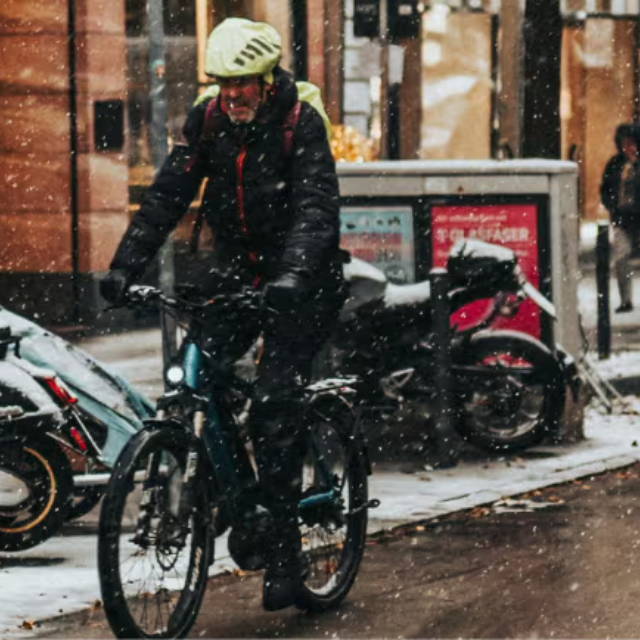Electric bikes function just fine in wet weather due to their highly water-resistant parts and protective seals. Extended exposure can increase the likelihood that water finds its way toward critical areas of the battery or controller, but most moisture will stay away. If you do experience water damage, contact the manufacturer or retailer for warranty information.
Slippery When Wet: Are E-Bikes Waterproof?
Written by: Rémy Rossi | March 6, 2025 | Time to read 6 min
Electric bikes are highly water-resistant and built to withstand heavy rain and puddles— just don’t take them into the bath with you.

More about the Author: Remy Rossi
Rémy Rossi is a bike writer, mechanic, and educator who got his start in community-based bike shops and co-ops. With a decade in the industry, he still wrenches on bikes when he can and plays bike polo on a fixie.

In this article, I’ll teach you all about the water resistance of e-Bikes and what to do when you encounter drizzle, downpours, or deep mud on your next rainy ride.
👋 Do you know Upway?
Can I ride my e-Bike in the rain?
Absolutely! E-Bikes are highly water-resistant and can get wet without the risk of damaging their electrical components. Whether you’re trudging through mud puddles on an electric mountain bike or commuting in an unexpected shower, e-Bikes keep rolling rain or shine.
E-Bikes have protective seals to keep moisture away from electric parts so you can safely ride in the rain and wash your bike. In fact, electric bicycles are so water-resistant that it’s more likely that riders would throw in the towel before any torrential wet weather conditions would be too much for electric bikes to handle.

Are electric bikes waterproof?
🤝 Why you can trust us for buying an e-Bike?
- Fair Prices: Find your next e-Bike at up to 60% off retail, in new or like-new condition.
- Quality You Can Trust: Each e-Bike is meticulously certified by our expert mechanics and backed by a 1-year warranty.
- Convenient Delivery: Enjoy doorstep delivery within a week. Not completely satisfied? Take advantage of our 14-day return policy.
What is an IP rating?
An IP (Ingress Protection) rating specifies the limits of water ingress on an e-Bike— essentially, its level of water resistance. Most e-Bikes have batteries, motors, and displays with ratings between IP65 and IP67. The first digit refers to protection against solids like dust, with 6 being the highest. The second indicates protection against liquids, with a top possible score of 8.

IP66: Protection from powerful water jets
IP67: Protection from temporary immersion in water, up to 1 meter for 30 minutes
With so much protection, your electric bike is very unlikely to be damaged by rain or exposure to water. For other sticky situations like crashes or theft, e-Bike insurance can be a big help. Our partners over at Sundays Insurance specialize in standard bicycles and electric bicycles to ensure you’ve always got the right coverage.
Do’s and Don’ts for Riding in Wet Weather
Do ride your e-Bike in the rain!
Don’t let a few droplets rain on your parade and prevent you from going outside. Just remember to prepare yourself and your e-Bike for wet surfaces. Wear appropriate water-repelling apparel, and run lower tire pressure for extra grip in the rain.
Commuter bikes and some e-MTBs have fenders to limit wheel spray and protect riders from getting wet. Prepare for the cold, wet riding season and winterize your e-Bike before the first snow hits.
Do wash your bike frequently
E-Bikes can get wet and perform better when they are clean. A quick rinse with soapy water or wipe-down after dirty rides will get rid of any unwanted debris and grime. Immediately dry the e-Bike with a soft, dry cloth to remove any remaining water near the electric motor or battery. Finally, make sure to dry and lubricate the chain to prevent rust.

Don’t leave your e-Bike in the rain for long periods

Don’t ride through deep puddles or submerge your bike in water
This may seem obvious, but unexpected stream crossings are riskier for e-Bike batteries and motors than normal, light rain conditions. To avoid potential water damage or an electrical malfunction, turn off your e-Bike’s motor when riding through deep water.
Frequently Asked Questions
What happens if an electric bike gets wet?
Is it OK to leave e-Bikes in the rain?
Yes, leaving your e-Bike in the rain for short periods is fine and won’t lead to water damage. However, leaving your e-Bike in the elements for a long time in areas with rain, high humidity, or snow may cause eventual corrosion of sensitive components or mechanical parts like a rusted chain.
Is it OK to keep electric bikes outside?
Electric bikes are designed to explore the great outdoors and can be left outside with no problem. Avoid leaving e-Bikes (or any bike) in inclement weather which can lead to rust or corrosion of parts over time. At home, keeping your electric bike inside the house or garage and properly locked is always safer.
Can I wash my electric bike with water?
Yes, cleaning your used electric bike with soap and water is a crucial part of regular bike maintenance. Use a large sponge and a bucket of water or a hose to remove mud and dirt. If you’re using a pressure washer, stand far enough back or use a bicycle-specific nozzle that limits the water pressure, and avoid spraying directly at the battery and motor seals.
Key Takeaways
- E-Bikes Are Water-Resistant: Modern electric bikes are designed to handle rain, puddles, and wet conditions thanks to protective seals and high IP ratings.
- Proper Care is Key: Regular cleaning, drying, and proper storage help prevent rust and electrical issues. While short-term exposure to rain is fine, long-term exposure should be avoided.
- Riding Safely in Wet Conditions: Riders should wear waterproof gear, install fenders, lower tire pressure for better traction, and avoid deep puddles or streams to prevent potential water damage.


